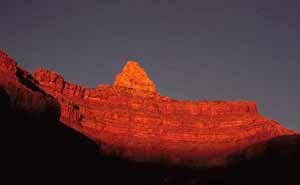REDWALL LIMESTONE & SURPRISE CANYON FORMATION
 |
Fig.
16
|
The Redwall Limestone contains bryozoan fossils, preferentially
silicified blue-green algal mats, and crinoidal debris, whereas the
Surprise Canyon Formation contains various types of corals, brachiopods,
and echinoderms with reported forms of bivalves, gastropods,
cephalopods, trilobites, and shark teeth. The Surprise Canyon Formation
has also yielded a moderate amount of plant fossil material, infact, 22
species of spores were identified from the Granite Park area. The
Redwall Limestone sediments were deposited in a shallow epeiric sea that
produced a submerged continental shelf across northern Arizona. The
deposits were fromed during two major transgressive-regressive pulses.
The distribution and nature of the Surprise Canyon strata suggest that
the entire formation was deposited within the confines of a broadly
dendritic stream valley system and in the associated caves and collapsed
depressions formed on a limestone platform.
 Fig. 17 -
Algal stromatolites (oncolites) from near the top of the Surprise Canyon
Formation at Quartermaster Canyon section 4. Centimeter
scale.
Fig. 17 -
Algal stromatolites (oncolites) from near the top of the Surprise Canyon
Formation at Quartermaster Canyon section 4. Centimeter
scale.
 Fig. 18 -
Fossil nautiloid on stream-polished outcrop of Mississippian Redwall
Limestone.
Fig. 18 -
Fossil nautiloid on stream-polished outcrop of Mississippian Redwall
Limestone.




